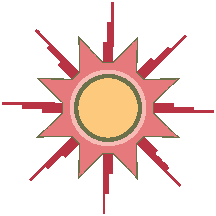

Day 2: Flagstaff to Canyon de Chelly
The next morning, having arrived safe and sound in Flagstaff the night before, we decided to do some exploring of the town. It has some beautiful old sandstone buildings in its old downtown, which is very well preserved. It was Sunday morning so very little was open. Still, we had a nice walk and got to stretch our legs after the previous day's long drive.
The last three photos show the house -- or rather, twin houses -- belonging to two brothers and their families. The brothers became wealthy in the timber industry in Flagstaff, so wanted to build their homes as a tribute to the material that had made them rich. The houses are joined by a common area that is a recreation room, and since they were built in the early twentieth-century arts and crafts period, they have stained glass and lots of other beautiful wood and stone details. From Flagstaff, we drove east along what was once the famous route 66. A few traces of the highway in its heyday remain, like this fifties style motel. note the antique cars parked in front of each of the "wigwams."
Toward the eastern border of Arizona is Petrified Forest National Park, where traces of an ancient forest, now fossilized, remain.
Also in the park is what is known as the Painted Desert, because of the multicolored rocky hills. (For Albertans: it is much like the Badlands around Drumheller, but stretches for miles and miles.)
Also in the park are another set of ruins of the Sinagua people. At this site, they built on the top of a steep hill, probably for defence, and also left numerous pictographs carved into the rocks nearby.
from there we drove north to Chinle at the edge of the Canyon de Chelly. Chinle, and most of Arizona east of Flagstaff and north of the Petrified Forest, is in the Navajo Indian reservation, or Navajo Nation, as the Navajos themselves call it. it is huge, and includes parts of western new Mexico and southern utah as well as much of northeast arizona. That evening, and for the next few days' meals while staying in the navajo nation, we feasted on traditional Navajo dishes: lamb and pork stew, Navajo tacos, and fry bread. the navajos, like most native american indians, are trying to preserve their way of life. These photos below show a traditional Navajo house, called a hogan. although most homes on the reservation were in a style that would be typical for us, most also had a hogan near the house, for ceremonies.
to return to the main page, simply close this page.
to go on to the photos for Day 3, click here.